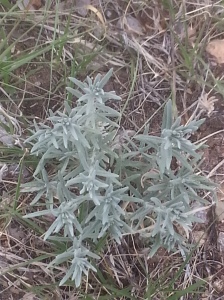Winterfat was startlingly beautiful covered in fluffy seeds the fall that I bought my 5 acres in the mountains. Not on my property, mind you, but along the road driving in. The plant is a gray green covered in white hairs, plus the white spikes of cotton, and it was beautifully back lit by the late afternoon sun. First thing I did when I moved in was sprinkle some of those seeds along my driveway. Nothing. Second year, nothing. Third year, nothing. This year I have 4 Winterfat shrubs coming up along my driveway.
This is the biggest one, the other 3 are half its size. It might be 4 inches tall. I want more! I was about to give up on them, but we had the late 40 inches of snow and here they are. Everything I read said they only sprout when we have late wet snows. So far that seems true.
Although this sturdy shrub maxes out at 3×3 feet, it can live 130 years and has a deep tap root. Plan for the future, you can kill it but probably not transplant it.
Called Winterfat because it is green all winter and fattens up the game animals like big horn sheep, elk, mule deer, and pronghorn antelope. Rabbits, small mammals, and birds eat it too. The leaves are about 10 percent protein, excellent for getting game through winter in good condition.
As you might guess, cattle, horses, and sheep also thrive on Winterfat in the cold western Intermountain deserts. Its common range gets a mere 7-16 inches of rainfall but it is seen in areas with less or more rain.
This plant looks much different than its cousins beet and spinach, but it is edible. I didn’t want to go nibbling on the neighbors’ stuff, but now that I have Winterfat of my own, different story. Right now in early spring, it has a nice mild taste, although the furry business lasts through the first chew or two. Definitely edible. I will continue small taste tests (they are tiny) through winter.
My biggest goal in gardening is to have live food 12 months out of the year. I have few species that could get me through winter, and Winterfat, Prickly Pear, One Seed Juniper berries, and Pinon Pine is about it so far. Meat, of course, since that is rabbit season. Four plants are not enough, but they will increase.
First Americans threw branches of Winterfat on the fire in their sweat lodges, and it has a mildly sweet smell. At some point I will try distilling its essential oil. A cold infusion was used as a “life medicine” and my guess is that is a good way to access its Chenopodium nutrition without the hairy leaves thing. A poultice of the leaves is used on sores, boils, smallpox, poison ivy and sore muscles. Hot tea is a good scalp wash to treat head lice, and as a tonic to slow hair loss and prevent graying. Tea is also used to treat fevers and as a wash or compress for sore eyes. Powdered root is applied to burns.
I am glad I persevered for 3 barren years with no results. Winterfat is worth the effort for all it has to offer my food forest and circular economy. Its scent is soft and mild, very much part of the mountain west where Winterfat grows.
Winterfat is a new plant for me, it is a new experience as I start to live with it. I still have the first thought that Winterfat seed fluff could be carded and spun into a fine yarn and fabric, but no mention of anyone trying.

